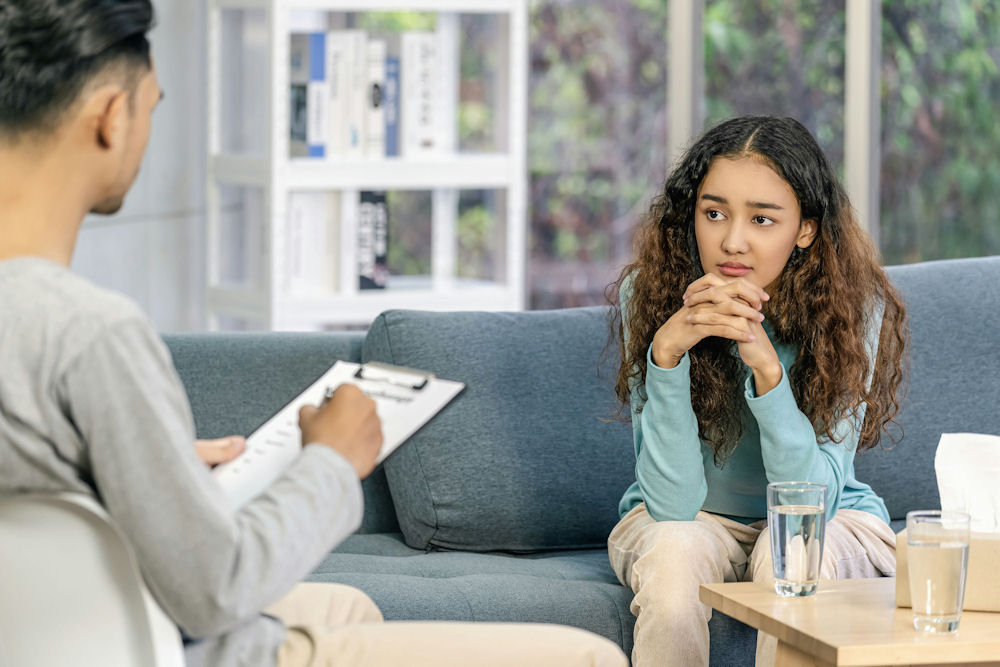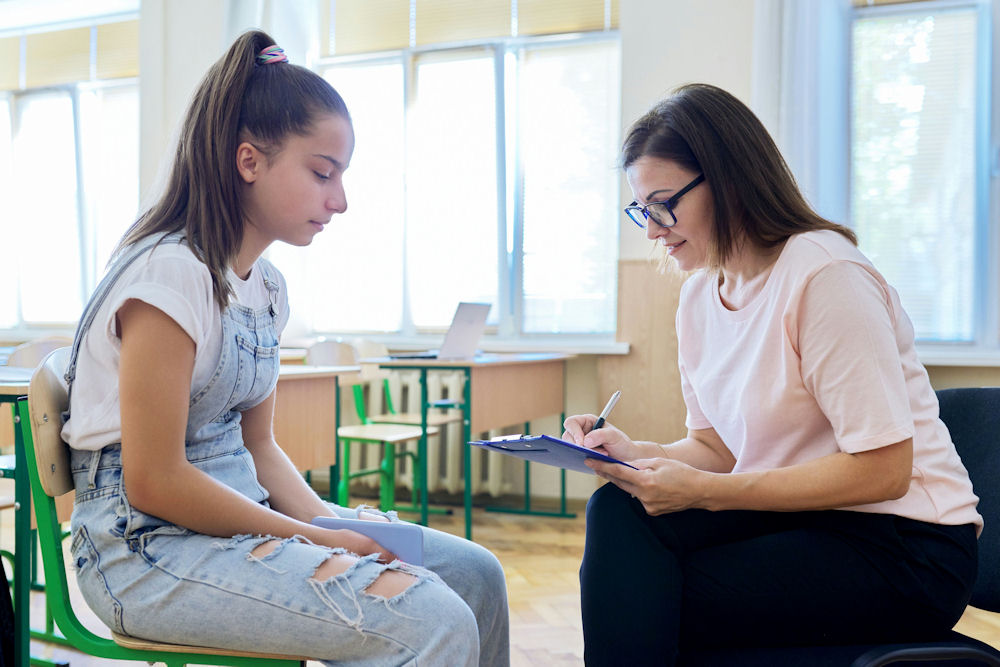Cognitive behavioral therapy (CBT) is a widely used, evidence-based approach for treating a variety of mental health conditions in children and adolescents. Addressing adolescent mental health is especially important, as evidence-based therapies like CBT are tailored to the unique developmental and emotional needs of this age group.
Cognitive behavioral therapy (CBT) is a widely recognized and highly effective form of talk therapy designed to help individuals, especially children and adolescents, manage a range of mental health conditions. CBT is particularly successful in treating anxiety disorders, depressive disorders, and other mental health symptoms by focusing on the powerful connection between thoughts, feelings, and behaviors. The core idea behind cognitive behavioral therapy is that our thoughts affect emotions, and in turn, those emotions influence our actions.
When negative thought patterns take hold, they can lead to anxiety symptoms, depressive symptoms, and behavioral problems. Through CBT, young people learn to identify these unhelpful thoughts and replace them with healthier, more realistic perspectives. This evidence-based approach has been demonstrated to be an efficacious treatment for a variety of mental health issues, helping children and adolescents build resilience and improve their overall mental health.

Navigating the teenage years can be challenging. From school pressures to friendships, and everything in between, it can sometimes feel overwhelming. Teen CBT is a specialized approach designed to address the unique needs of adolescents. Cognitive behavioral therapy (CBT) offers a structured and evidence-based approach to help teens understand and manage their thoughts and behaviors effectively.
CBT techniques help teens work through their unique challenges by addressing their thought patterns, emotions, and behaviors in a way that is tailored for adolescents. CBT is also designed to teach teens practical skills for managing their thoughts and emotions, improving their emotional regulation, and resilience.
By fostering healthier thinking patterns and responses, CBT empowers teens to handle life’s challenges with greater confidence and resilience. Explore the benefits of CBT and discover how it can positively impact your teen’s well-being and personal growth. Building a strong therapeutic alliance between the therapist and the teen is essential for effective treatment and lasting positive change.
Cognitive behavioral therapy (CBT) is a form of psychological treatment that focuses on changing unhelpful thoughts, beliefs, and behaviors. It is based on the concept that our thoughts, emotions, and actions are interconnected. Negative thoughts and feelings can trap us in a vicious cycle, influencing our behavior and emotional state.
CBT aims to help individuals identify and challenge these negative patterns. By doing so, it promotes the development of healthier ways of thinking and behaving. Through structured therapy sessions, individuals learn specific CBT skills to reframe their thoughts and adopt more positive behaviors, ultimately improving their overall mental health and well-being. CBT follows a structured therapeutic process to achieve these positive outcomes.
Cognitive behavioral therapy (CBT) for teens helps with a variety of emotional and behavioral issues, including:
CBT helps teens manage irrational fears and worries. CBT also addresses the prevalence and impact of anxiety disorders in adolescents, helping them cope with symptoms that can impair daily functioning.
CBT assists teens in overcoming difficulties in social situations by addressing negative thoughts and building confidence.
It promotes healthier thinking and behavior by addressing negative patterns.
CBT is an effective treatment for obsessive-compulsive disorder, helping teens manage intrusive thoughts and compulsive behaviors.
CBT provides techniques to handle stress effectively.
It boosts confidence by changing negative self-perceptions. CBT can also boost self-esteem through positive feedback and helping teens challenge negative self-perceptions.
CBT helps modify disruptive behaviors and improve decision-making.
It enhances communication and interpersonal skills.
It enhances communication and interpersonal skills.
It teaches alternative coping mechanisms to manage triggers.
CBT helps process traumatic experiences and reduce PTSD symptoms.
Overall, CBT helps teens develop practical skills to manage their thoughts, emotions, and behaviors, leading to improved mental health and daily functioning. The main goal of CBT is to help teens identify and challenge unhealthy thought patterns and negative thinking, supporting better emotional and behavioral outcomes. CBT is also effective for young adults and young clients, and setting clear treatment goals is an important part of the therapy process.

Thoughts, emotions, and behaviors are closely linked and significantly influence each other. This relationship is explained by the cognitive-behavioral model, commonly used in psychology to understand human behavior and mental health.
Our thoughts are our interpretations, beliefs, and perceptions about ourselves, others, and the world. These thoughts can be automatic and are shaped by our past experiences, knowledge, and attitudes. For example, thinking, “I am going to fail this test,” can lead to feelings of anxiety or fear. In contrast, positive thoughts like “I am prepared and capable” can create feelings of confidence and calm. Positive thinking can lead to positive emotions and healthier behaviors, supporting overall mental well-being.
Emotions are the feelings we experience in response to our thoughts and external events. They can be positive (like happiness or excitement) or negative (like sadness or anger). Emotions are powerful and can significantly affect our physical and mental states. Feeling anxious about failing a test might lead to avoiding studying or procrastinating, creating a self-fulfilling prophecy. Conversely, feeling confident might lead to diligent study and good performance.
Behaviors are the actions we take or the way we respond to our thoughts and emotions. These include how we act in different situations, our verbal responses, and our body language. Positive behaviors, like practicing mindfulness or exercising, can lead to more positive thoughts and emotions. Negative behaviors, such as withdrawing from social interactions, can reinforce negative thoughts and feelings.
CBT intervention targets these interconnected patterns of thoughts, emotions, and behaviors to promote mental well-being and support healthier habits.
Thinking distortions, or cognitive distortions, are irrational or biased ways of thinking that can reinforce negative emotions. Common cognitive distortions include:
Seeing things in black-and-white terms, with no middle ground. For example, if something isn’t perfect, you see it as a total failure.
Making broad generalizations based on a single event or evidence. For instance, if you fail one test, you conclude you’re bad at everything.
Exaggerating the importance of negative events or minimizing the importance of positive events. For example, making a small mistake at work becomes a catastrophe in your mind.
Taking responsibility for events outside your control. If something goes wrong, you blame yourself even when you’re not at fault.
Taking responsibility for events outside your control. If something goes wrong, you blame yourself even when you’re not at fault.
Efficacy studies have shown that CBT is effective in helping teens identify and overcome cognitive distortions and negative thinking.
The CBT process is a structured journey that empowers teens to take control of their mental health by addressing negative thought patterns and building practical coping skills. It begins with helping teens recognize how their thoughts, emotions, and behaviors are interconnected. With the guidance of a trained therapist, teens learn to identify negative thought patterns that contribute to mental health issues and work to challenge and reframe them.
CBT techniques such as cognitive restructuring, exposure therapy, and problem-solving are introduced to help shift negative thought patterns and encourage more positive, realistic thinking. Throughout the CBT process, teens are encouraged to practice these new coping skills in real-life situations, reinforcing their ability to manage difficult emotions and behaviors. Each therapy plan is tailored to the individual, ensuring that the approach supports their unique mental health needs and personal growth goals.
CBT treatment includes a range of interventions tailored to the needs of teens and, in some cases, younger children.
CBT interventions include a variety of techniques to help teens manage their thoughts, emotions, and behaviors:
Identifying and challenging negative thoughts, often using models like the ‘ABCDE model’ to help recognize and challenge irrational beliefs.
Engaging in activities that improve drastic mood swings and reduce avoidance.
Gradually facing feared situations to reduce anxiety.
Developing effective solutions to challenging situations.
Learning methods like deep breathing and progressive muscle relaxation to manage stress.
Practicing present-moment awareness to reduce rumination and increase emotional regulation.
Writing about thoughts and feelings to gain insight and track progress.
Tracking symptoms and behaviors to identify triggers.
Educating about mental health and CBT principles, including how CBT treatment works.
Combining acceptance with behavior change to increase flexibility.
Gradual exposure to feared situations.
These interventions can be used individually or in combination, depending on the individual’s needs and the specific issues they are facing. Some CBT treatment interventions may need to be adapted for younger children due to developmental differences, as techniques and effectiveness can vary based on age and cognitive maturity.
A key element of cognitive behavioral therapy is its behavioral approach, which targets the behavior patterns that often contribute to mental health issues in children and adolescents. This approach is grounded in the understanding that behaviors are learned and, with the right support, can be changed. Therapists work closely with teens to identify negative behaviors—such as avoidance, withdrawal, or unhealthy coping mechanisms—and help them develop more adaptive responses, like building social skills and practicing effective coping skills.
By using positive reinforcement, modeling, and other behavioral techniques, CBT helps young people replace maladaptive behaviors with healthier habits. This approach has proven effective in reducing symptoms of anxiety disorders, depressive disorders, and other mental health conditions, supporting children and adolescents as they work toward improved mental health and well-being.
Tapping into the mind-body connection can enhance overall well-being and promote a balanced lifestyle. Here are some effective tools and practices:
Paired muscle relaxation involves tensing and relaxing different muscle groups to promote relaxation and physical awareness. Start from the feet and move to the head, tensing each group for 5–10 seconds, then relaxing for 15-20 seconds. Deep, slow breaths enhance the effect, reducing tension and increasing stress awareness in the body.
Relaxed breathing is a technique to calm the mind and body through deep, controlled breaths, reducing stress and anxiety. Sit or lie down comfortably with your back straight and shoulders relaxed. Inhale slowly through your nose for 4 counts, hold for 2-4 counts, then exhale through your mouth for 6–8 counts. Repeat for several minutes, focusing on relaxation. Regular practice lowers the heart rate, reduces blood pressure, and promotes well-being.
Temperature change uses thermal stimuli to affect the body and mind. Warm baths, showers, or heat packs relax muscles, improve circulation, and reduce stress. Cold compresses or showers reduce inflammation and numbness and invigorate the body. Contrast therapy, alternating between hot and cold, stimulates blood flow and reduces muscle soreness. These methods help manage stress, relieve discomfort, and enhance the mind-body connection.

Self-awareness is a cornerstone of effective CBT, playing a vital role in helping teens understand how their thoughts, feelings, and behaviors impact their mental health. By developing self-awareness, teens can more easily recognize negative thought patterns and identify the triggers that lead to anxiety symptoms, depressive symptoms, or other mental health challenges.
This heightened awareness allows them to apply coping skills learned in therapy, manage difficult emotions, and make healthier choices. As teens become more self-aware, they often experience a boost in self-esteem and develop a more positive self-image, which contributes to their overall mental well-being. Ultimately, self-awareness empowers teens to take charge of their mental health, fostering resilience and supporting lasting personal growth.
CBT for teens is most effective when they consistently practice the skills until they become second nature. Teens work to apply CBT techniques by actively engaging with their thought patterns, emotions, and behaviors, which supports lasting benefits. Results vary, but CBT greatly enhances emotional intelligence and self-awareness in the long term. Additionally, practical CBT techniques can be lifelong tools for teens, helping them reframe their thoughts whenever needed.
CBT helps manage anxiety, depression, and other issues long-term.
Teens learn effective strategies for handling stress and difficulties.
CBT fosters critical thinking and logical problem-solving.
Teens become more resilient to setbacks and challenges.
Improved communication leads to better relationships.
CBT boosts self-awareness and self-confidence.
Healthy coping mechanisms lower the risk of drug use.
Better focus and reduced anxiety improve academic performance.
CBT promotes lasting positive behavior changes.
Combined benefits enhance overall well-being and life balance.
By participating in CBT, teens can develop a strong foundation for mental health and well-being that supports them throughout their lives.
CBT is typically a short-term therapy, lasting between 8 to 20 sessions, depending on the teen’s needs and goals.
Yes, numerous studies have shown that CBT is effective for treating a wide range of mental health issues in teens.
It’s common for teens to be hesitant about therapy. A skilled therapist can engage teens by building rapport and explaining how CBT can help them achieve their personal goals.
Parental involvement can be beneficial, especially for younger teens. Parents can support the therapy process by reinforcing new skills and providing a supportive environment at home.
At Blume Behavioral Health, we specialize in providing CBT for teens. Our experienced therapists are dedicated to helping teens overcome their challenges and achieve their full potential. We offer personalized treatment plans tailored to each teen’s unique needs and goals.
Whether your teen is struggling with anxiety, depression, or any other mental health issue, we are here to help. Contact us today to learn more about our services and how we can support your teen’s journey to better mental health.
Dr. Aneta Lotakov Prince is a board-certified psychiatrist with over 20 years of clinical experience treating adolescents and adults facing severe mental illness, co-occurring substance use disorders, and complex emotional and behavioral health challenges. Certified by the American Board of Psychiatry and Neurology, she holds an active DEA registration and California medical license. Dr. Prince’s patient-centered approach is rooted in compassion and driven by a dedication to improving quality of life and supporting long-term recovery. She remains deeply committed to empowering each individual she works with to build a life of purpose, connection, and resilience.